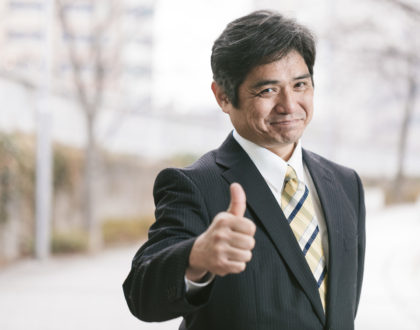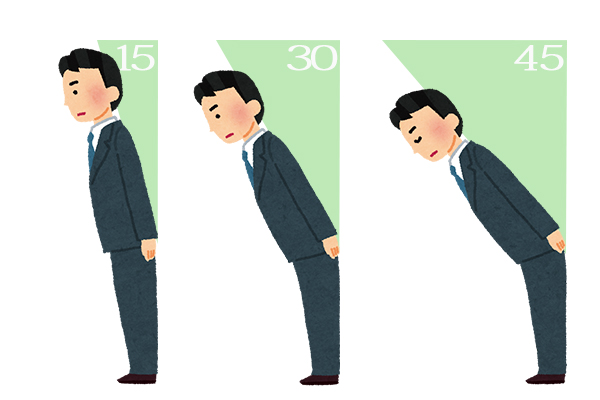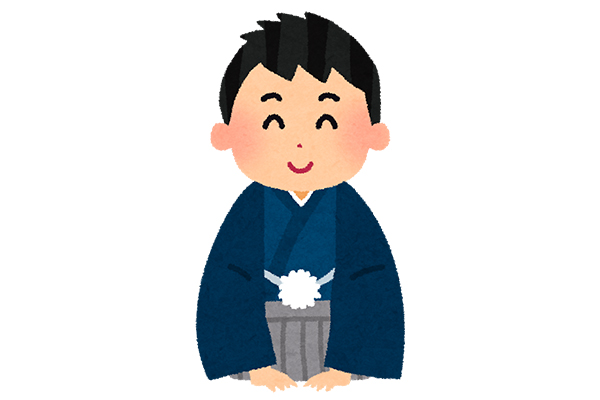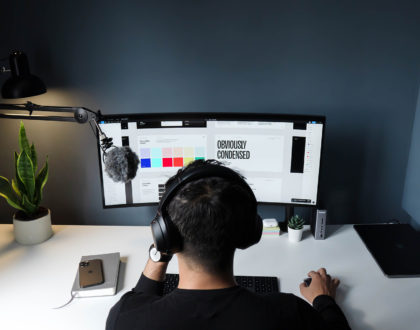Bowing in Japan: The Right Bow for Every Occasion

by Madelaine
Japanese people bow, a lot. It seems as natural to them as does walking, but to little surprise, strict etiquette rules are at work here.
If in doubt bow 30 degrees. How respectful your bow is depends on the duration and angle but when in a pinch this rule of thumb can be a lifesaver. However, for a successful job-hunt and good work-life, knowing which bow is appropriate for each situation is essential.
コンテンツ
Bowing manner
Bowing is said to have been introduced to Japan via Buddhism and is a sign of goodwill. The two main types of bows in Japan are the traditional seated bow, 座礼 (ざれい), and the standing bow, 立礼 (りつれい). The standing bow is used in business and what we focus on in this article.
No matter which kind of (standing) bow you are going for, always do the following things.
- Keep your feet together.
- Place your hands at your sides (men) or put one on the other in front of your waist (women).
- Move only your upper body. Your legs shouldn’t move.
- Keep your back straight at all times.
- Keep your head straight and look down while bowing.
- Keep the position for one breath – Inhale (down), exhale (stay), inhale (up) – or count to three.
- Bow fast but come up slowly.
- First fully come up before making eye contact.
Move your whole upper body. Just nodding your head is not enough and makes it look like you are slouching. Another common mistake is wanting to look up during the bow. Let’s put ourselves in the other person’s shoes – it’s kind of creepy, isn’t it?
Slight bow
For the 会釈 (えしゃく) bow 15 degrees. To get the angle right look at a place 3 meters in front of your feet while keeping your head straight. Sometimes when you are running into someone on the streets or stairs stopping might be difficult but try to stop even a second.
- ✔ Greeting or thanking staff (eg. receptionist at job interview).
- ✔ Meeting people when entering or leaving the company.
- ✔ Running into colleagues or clients on the stairs, street, etc.
Normal bow
Bow 30 degrees for a normal bow, 敬礼 (けいれい). This time look on the ground 1 meter before you. It is the most common bow and can be used in almost all situations.
- ✔ At the beginning of a job interview.
- ✔ Greeting customers.
- ✔ Visiting other companies.
- ✔ Towards people of higher social status (judge by age if unsure)
- ✔ Whenever you are unsure how to bow.
Deep bow
The 最敬礼 (さいけいれい) is a very formal bow, with an angle of 45 degrees. Depending on the occasion, you can bow longer here. For example, when seeing off customers it is common to wait until the doors closed behind them.
- ✔ When saying thank you at the end of a job interview.
- ✔ Facing higher ranking people.
- ✔ Conveying deep gratitude.
- ✔ Apologizing deeply.
- ✔ Seeing off important customers.
You can also bow deeper to show even more respect. The maximum for this bow is 90 degrees but this angle is only used when apologizing for grave errors. You will want to look just in front of your toes during this one.
Seated bow
For seated bows, you have the same three types of bows at 15, 30, and 45 degrees respectively. The starting position is the traditional Japanese way to sit on the ground. For the bow both hands are placed on the floor in front of you, forming a small triangle by turning your hands slightly inwards. Bow from this position to the desired degree.
You may have seen pictures of people lowering their head to the ground in this kind of bow but that is the most extreme and rare case. That bow is called 土下座 (どげざ) and it is only used in extreme cases, so it’s unlikely you will ever see it.
Extra: Mock bow
This is not really a bow at all but you will often see Japanese people just nodding their heads when greeting or engaging with family or friends. Feel free to try it out sometime, just make sure you keep it out of the office.
Observe and follow the example of Japanese people around you to really get a feeling for the whole bowing thing. It might take some time getting used to, but after a while it will come as natural as nodding your head in agreement or the casual 「ありがとうございます」 at the register. The sign of true mastery? When you start bowing while on the phone.
Recommended Posts

How to Get Along with Your Japanese Boss
25 5月 2021 - Work, Working Culture

The 10 Most Popular Japanese Companies in 2021
19 5月 2021 - Work



